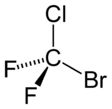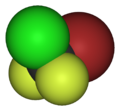- Bromochlorodifluoromethane
-
Bromochlorodifluoromethane 
 BromochlorodifluoromethaneOther namesChlorodifluoromonobromomethane, Halon 1211, Halon 1211 BCF, BCF, Freon 12B1
BromochlorodifluoromethaneOther namesChlorodifluoromonobromomethane, Halon 1211, Halon 1211 BCF, BCF, Freon 12B1Identifiers CAS number 353-59-3 
PubChem 9625 ChemSpider 9248 
UNII 91I5X8AJXS 
EC number 206-537-9 Jmol-3D images Image 1
Image 2- C(F)(F)(Cl)Br
BrC(Cl)(F)F
Properties Molecular formula CBrClF2 Molar mass 165.36 g/mol Density 1.799 g/cm3 Melting point −159.5 °C
Boiling point −3.7 °C
 (verify) (what is:
(verify) (what is:  /
/ ?)
?)
Except where noted otherwise, data are given for materials in their standard state (at 25 °C, 100 kPa)Infobox references Bromochlorodifluoromethane, also known by the trade name Halon 1211, or BCF, or Halon 1211 BCF, or Freon 12B1, is a haloalkane with the chemical formula CF2ClBr.
Brominated haloalkanes were first used during World War II as fire extinguisher for aircraft and tanks. Bromochlorodifluoromethane was introduced as an effective gaseous fire suppression agent around 1973 for use around highly valuable materials in places such as museums, mainframe rooms and telecommunication switching centers. They were also widely used in the maritime industries in the engine rooms of ships. Its efficiency as a fire extinguishing agent has also led it to be the predominant choice of fire extinguishing agent on commercial aircraft and is typically found in cylindrical hand-held canisters. Its advantages as a fire extinguishing agent are that it has lower toxicity than chemicals such as carbon tetrachloride and that since it is a covalently bonded compound, it does not form conductive ions, therefore being usable on electrical equipment.
Contents
Ozone depleting substance
The production of bromochlorodifluoromethane and similar chlorofluorocarbons has been banned in most countries since January 1, 1994 as part of the Montreal Protocol on ozone depleting substances. However, recycling of halon 1211 allows it to remain in use, although parts availability is limited to a few manufacturers and can be an issue. Halon 1211 is still widely used in the United States, despite its high cost, with the US Military being the biggest user, but Europe and Australia have banned its use for all but "critical applications" such as aviation, military, and police use.
The manufacture of UL Listed halon 1211 extinguishers was supposed to cease on October, 2009. The future listing is still in discussion. Halotron I is the replacement extinguishing agent. It takes a larger volume to get the same ratings as 1211 has.
This is a volatile extinguishing agent that should be used only with a breathing apparatus.
See also
References
- George H. Tryon et al., "Fire Protection Handbook Thirteenth Edition 1969", National Fire Protection Association, Boston Massachusetts, 1969, Library of Congress 62-12655, no ISBN.
- Arthur E. Cote et al., "Fire Protection Handbook Eighteenth Edition", National Fire Protection Association, Quincy, Massachusetts, 1997, ISBN 0877653771
External links
- International Chemical Safety Card 0635
- Institut national de recherche et de sécurité (1988). "Bromochlorodifluorométhane." Fiche toxicologique n° 165. Paris:INRS. (French)
- Basic Facts about Halon
- MSDS at ansul.com
- Recycling Halon
- Aviation fire extinguisher requirements
Halomethanes Monosubstituted Disubstituted Trisubstituted Categories:- Halomethanes
- Fire suppression agents
- Greenhouse gases
- Air safety
- Organobromides
- Organochlorides
- Organofluorides
- C(F)(F)(Cl)Br
Wikimedia Foundation. 2010.
